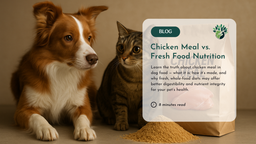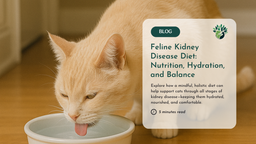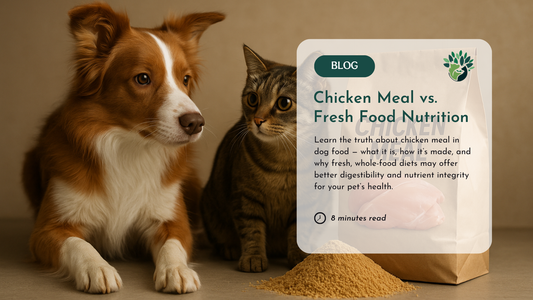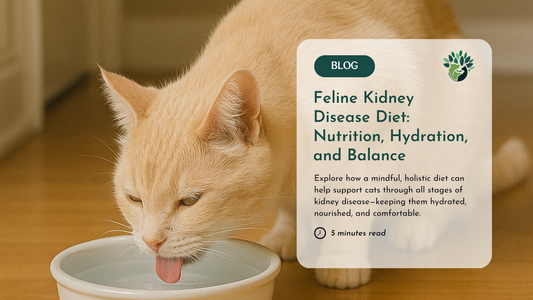Expert, science-backed advice from Dr. Ruth Roberts and Dr. Chris Bessent
Feeding a dog with kidney disease is all about balance. Too much phosphorus can strain the kidneys, but cutting protein too far can cause muscle loss and weakness.
The key is finding the right mix; enough high-quality protein to keep your dog strong, with controlled phosphorus to protect kidney function.
In this Healing Tails conversation, Dr. Ruth Roberts and Dr. Chris Bessent dig into the details, covering how a whole-food kidney diet can hit clinical targets, protect muscle, and still be something your dog wants to eat.
Key Takeaways
-
Quality kidney nutrition for dogs lowers phosphorus while keeping moderate protein to avoid muscle wasting.
-
There is no one size fits all! The way you feed your dog with kidney disease will entirely depend on the stage of the illness and the foods your dog will tolerate.
-
Whole food formulas provide amino acids, omega-3s, antioxidants, and phytonutrients that ultra-processed diets prescribed diets often lack.
-
Hydration is essential for any dog with kidney issues. Focus on feeding a moist diet and making sure your dog takes in as much water as possible throughout the day.
Rather watch/listen? Catch up with the full episode of Healing Tails here.
What is Chronic Kidney Disease in Dogs?
Chronic kidney disease happens when your dog’s kidneys gradually lose their ability to filter waste, balance fluids and electrolytes, and regulate blood pressure.
There are a number of symptoms associated with canine kidney disease. You might notice your dog is more thirsty and urinates more, is losing weight, has a picky appetite, nausea or vomiting, bad breath, low energy, a dull coat, or dehydration.
While canine kidney disease is a serious condition, it doesn’t have to be a death sentence. With early detection, the right diet, and ongoing care, many dogs can live comfortably for years after diagnosis.
Nutrition for Dogs with Kidney Disease: What A Kidney Diet Needs To Do
Nutrition for dogs with chronic kidney disease or kidney failure doesn’t have to be complicated, but it should be carefully considered and informed.
When kidneys slow down, they don’t clear phosphorus well, so it builds up. That upsets calcium and parathyroid hormone and can weaken your dog’s muscles.
As Dr. Bessant explains in this Healing Tails episode, part of feeding a dog with kidney disease is ensuring they follow a low-phosphorus diet while still consuming enough high-quality protein so that muscle is maintained.
“If you have a dog with kidney disease, you need to restrict phosphorus because the kidneys can’t process it properly anymore. It builds up, throws off calcium balance, and affects muscle and bone health,” says Dr. Bessant.
The issue that both Dr Bessant and Dr. Roberts have encountered? Prescribed ‘kidney diets’ for dogs are often incredibly low in nutrients.
“My question was, why can’t we do the same thing using real food? Could we meet the same nutritional needs (as a prescribed kibble diet) with whole food ingredients like chicken, liver, hearts, blueberries, and cranberries? After years of research and testing, I can say with confidence that yes, we absolutely can,” said Dr. Bessant.
Prescription Kidney Diets vs. Homemade Kidney Diets for Dogs
When a dog is diagnosed with kidney disease, most vets recommend a prescription kidney diet as the first step.
While these commercial formulas are convenient and meet basic nutritional requirements, they’re also often made with ultra-processed ingredients, fillers, or low-quality protein sources that may not appeal to picky eaters or support long-term wellness.
A homemade kidney diet, on the other hand, allows you to use fresh, whole ingredients while tailoring meals to your dog’s stage of kidney disease and individual preferences.
So long as you have proper guidance, you can create balanced recipes that provide moderate protein, low phosphorus, healthy fats, and plenty of hydration.
Many pet parents find that dogs eat better and maintain muscle more easily on gently cooked, whole-food diets. Ultimately, the key difference between prescription and homemade comes down to control and quality. Prescription diets offer medical precision, but homemade diets offer flexibility and freshness, and in most cases better nutritional value.
The best approach is, as is often the case, somewhere in the middle.
You can combine both, using professional recipes, periodic lab monitoring, and a complete supplement such as Holistic Total Body Support for Dogs to ensure your dog receives all essential vitamins and minerals while protecting their kidney health but giving more support than that afforded by a processed ‘prescription diet’.
Why Whole Food Instead Of Ultra-Processed?
Whole foods pretty much always beat ultra-processed ones, but they’re especially important when feeding a dog with CDK (or any other chronic illness).
This is because whole foods provide more than just vitamins and minerals. They also contain natural compounds that help the body absorb nutrients better and stay stronger during illness.
One study published in the National Library of Medicine, for instance, looked at the effects of a whole food diet on immune function and inflammatory phenotype in healthy dogs, concluding that feeding dogs a whole food diet could have immunomodulatory effects (i.e., help to increase immune response).
On the flip side, the processing methods used in kibble and other UPFs can produce unwanted compounds and reduce nutrient quality (which is particularly counterproductive when feeding with CDK in mind!)
“Honestly, the pet food industry has become the wastebasket of human food, the human food industry,” explains Dr. Bessant.
“Many of the components that are used in pet food, particularly in kibble, are things that are byproducts, that are leftover, that are just going to be thrown away. And people thought, well, why don't we just add it to the kibble? And then we can put it on the label. And the pet parent will think, ‘Woo, we got tomatoes in the kibble!’ Well, really, we didn't. And unfortunately, how does the average person know that they don't?”
“It's kind of like in the 80s when the powers that be declared ketchup as a vegetable!” says Dr. Roberts.
Ultimately, if you are able to, when feeding your dog, especially if they have kidney issues, you should choose foods that name real meats, organs, and produce as ingredients. Freeze-dried or lightly cooked foods can be ideal. The CrockPET diet works well here.
Calorie Density During Healing
Another thing to consider is that healing demands energy. If your dog’s appetite is off, every bite needs to count.
As Dr. Ruth explains in this episode, “Two phases of life have the highest energy demands… growth and healing.”
One thing you can do in this case is make each cup work harder. This might mean choosing calorie-dense formulations, and using palatability boosters like warm broth or lightly warming your dog’s food.
Make Peace With Your Plan
Remember that the goal is comfort, function, and time well spent. A thoughtful kidney diet is one piece of a bigger picture that includes pain control, mobility support, and daily joy.
If you feel rushed toward choices that do not fit your values, pause, ask questions, and seek a second opinion.
While there are often better options than prescribed diets, it’s important to always design and monitor your dog’s diet under the guidance of either a veterinarian or a certified holistic pet health coach to ensure that you are meeting your dog’s specific medical and nutritional needs.
Want the full conversation?
Watch the Healing Tails episode with Dr. Ruth Roberts and Dr. Chris Bessent.
Looking to support your dog’s kidneys naturally?
Learn more with Dr. Ruth’s Holistic Care Plan for Pets With Kidney Failure
















